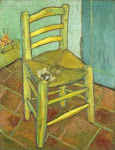
Catherine over at Versailles and More (I read this blog regularly, can you tell?) provides an apt comparison for the recent Wall Street collapse: the 17th-century phenomenon of tulip mania in the Netherlands. Allow me to add my two cents about tulip mania...
First, a reading recommendation: the novel "Tulip Fever," by Deborah Moggach. I read this after my trip to the Netherlands last year, wanting to learn more about tulip mania in a fun-reading way. I enjoyed this book very much, and if you're like me, when you get to a certain point near the end, you'll exclaim "Oh NO!" (Read it -- you'll see what I mean.)
And second, an interesting painting: pictured, "A Satire of Tulip Mania" by Jan Brueghel the Younger, ca. 1640. I discovered this painting on a visit to the Frans Hals Museum in Haarlem during my Dutch trip. It's a "singerie," a painting in which monkeys are used as an allegory to expose the foibles of humankind. Here is the museum's own description, from its website:
"One monkey points to flowering tulips while another brandishes a tulip and a moneybag. This is how artist Jan Brueghel indicates that this painting is about the tulip trade. A sale is concluded by hand-clapping. Bulbs are weighed, money is counted, a lavish business dinner is savoured. The monkey on the left has a list of names of expensive tulips. The sword at his side is a status symbol. Farther back, a monkey sits like a nobleman astride a horse. Another in the mid-foreground is drawing up a bill of sale. The owl on his shoulder symbolises folly. Brueghel is ridiculing tulip mania by depicting the speculators as brainless monkeys. The painting also shows what happened when the tulip trade crashed: a monkey on the right urinates on the - now worthless - tulips. Behind him a speculator who has run up debts is being brought before the magistrate. A monkey sits weeping in the dock and in the centre at the back a disappointed buyer is wielding his fists. At the back to the right a speculator is even being carried to his grave."
Brueghel's painting follows much of 17th-century Dutch genre painting by providing a moral lesson for the viewer, here done as a scathing satire of human greed. Vincent van Gogh knew about tulip mania; in a letter to his mother, he provides a comparison to the art market of his day that proves an odd premonition: "Those high prices one hears about, paid for work of painters who are dead and who were never paid so much while they were alive, it is a kind of tulip trade, under which the living painters suffer rather than gain any benefit. And it will also disappear like the tulip trade. But one may reason that, though the tulip trade has long been gone and is forgotten, the flower growers have remained and will remain. And thus I consider painting too, thinking that what abides is like a kind of flower growing. And as far as it concerns me, I reckon myself happy to be in it." (letter 612, November 1889, written in the asylum of Saint-Rémy).
I highly recommend the Frans Hals Museum to anyone visiting Haarlem, and I recommend Haarlem for anyone visiting the Netherlands. It's an easy train trip from Amsterdam and a charming town. The museum has a superb collection of mostly 17th-century Dutch art (it was larger than I expected), beautifully presented. Try to visit Haarlem on Saturday, when a market takes over the square around the cathedral of St. Bavo, and don't miss the cathedral itself -- Frans Hals' tomb is inside. The market of Haarlem will always be special in my culinary memory as the first place I had a stroopwaffel: a sort of waffle sandwich with syrup inside, but that description in no way captures the absolute heaven that is a stroopwaffel!






4 comments:
Thank you, Sheramy! I want to read this. The painting looks great too, but what about making the image a tad bigger?
See how demanding I am as a blog reader...
Hi Catherine:
If you click on the image (or any image in my blog), it will open in a separate screen at its regular size. I actually scanned that in from a museum postcard.
I prefer the images smaller on the main screen so they will load more quickly for dial-up readers (which includes me, at home) and for aesthetic reasons.
17th century Dutch art is one of my favourite subjects to lecture on. But I hadn't read any novel on the subject.
Then I was travelling down the escalators in the London Underground a few years ago, holding on for dear life because they are so steep. On the side wall was a repeated ad for Tulip Mania and a photo of Deborah Moggach. Needless to say I bought a copy of the book that very day and read it in one sitting.
Now I ask students to read the novel, before starting any Dutch art course. It has proved to be a painless, exciting way for undergraduates to feel the passions of those years.
many thanks
Helen Webberley
http://melbourneblogger.blogspot.com/
I have come back to the topic of tulip mania again. Great topic, isn't it? Even the economists love to talk about the economic issues involved in a manic investment commodity.
Thanks for the new link
Happy 2010 :)
Post a Comment